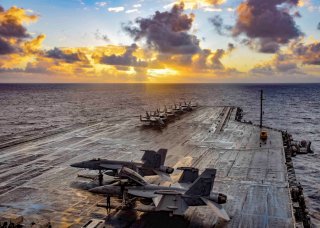The New USS Enterprise Will Be the Greatest Aircraft Carrier to Ever Sail
Most of the technologies are expected to be quite similar to the first two Ford-class carriers, yet they will likely integrate more quickly given that the Navy has had practice with the Kennedy and Ford.
Here's What You Need to Remember: The Enterprise is part of a Navy “two-carrier” buy plan designed by the Navy to lower production costs and streamline technological integration. The fourth Ford-class carrier, called CVN 81 is already progressing through several key planning and preparation phases.
Progressing quietly beneath the ongoing discussion about just what the future may hold for America’s aircraft carriers, the Navy’s third Ford-class carrier is powering along toward being ready for duty.
While there is naturally much focus upon the first-in-class USS Ford, which is nearing its first deployment, as well as the second-in-class USS Kennedy, the new USS Enterprise (CVN 80) is slated for delivery by as soon as 2028. Construction on the ship began in 2017, and builders are now performing early manufacturing and structural fabrication, Huntington Ingalls Industries (HII) Vice President of New Construction Aircraft Carriers, Lucas Hicks, told The National Interest in a written statement.
Most of the technologies are expected to be quite similar to the first two Ford-class carriers, yet they will likely integrate more quickly given that the Navy has had practice with the Kennedy and Ford. There are also new shipbuilding methods which have been progressing throughout the trajectory of Ford-class development, according to Hicks, who said HII is incorporating a number of lessons learned from building the Ford and Kennedy. The “build strategy” improvements, he said, including more outfitted superlifts, described at larger and more complete than on prior carriers.
“It will be the first aircraft carrier built completely using digital drawings and procedures rather than traditional paper work packages and products. The use of digital data and digital tools is more user-friendly and intuitive, making the execution of shipbuilders’ work more efficient,” Hicks explained.
Some of these construction innovations have already been underway with the USS Kennedy, the second Ford carrier slated to hit the ocean in the next few years. It involves a process Newport News Shipbuilders, a division of HII, describe as “modular construction” wherein ship compartments are assembled together before moving them to the dock to expedite the building process. Smaller segments of the ship are welded together into a structural “superlift,” as Hicks described with the Enterprise, to advance construction before the ship is lifted up into drydock.
Construction begins with the bottom of the ship and works up with inner-bottoms and side shells before moving to box units. The bottom third of the ship gets built first. Also, some of the design methods now used for the Kennedy include efforts to fabricate or forge some parts of the ship—instead of casting them because it makes the process less expensive, builders explained.
HII is working to take some of these newer methods to a new level with the Enterprise, a process which is in large measure being assisted or improved through the use of digital modeling. The Enterprise’s keel is slated to be laid in 2022, HII reports.
The Enterprise is part of a Navy “two-carrier” buy plan designed by the Navy to lower production costs and streamline technological integration. The fourth Ford-class carrier, called CVN 81 is already progressing through several key planning and preparation phases.
Kris Osborn is the defense editor for the National Interest. Osborn previously served at the Pentagon as a Highly Qualified Expert with the Office of the Assistant Secretary of the Army—Acquisition, Logistics & Technology. Osborn has also worked as an anchor and on-air military specialist at national TV networks. He has appeared as a guest military expert on Fox News, MSNBC, The Military Channel, and The History Channel. He also has a Master's Degree in Comparative Literature from Columbia University. This article is being republished due to reader interest.
Image: Flickr.

